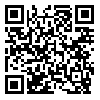Volume 16, Issue 3 (12-2023)
ijhe 2023, 16(3): 413-432 |
Back to browse issues page
Download citation:
BibTeX | RIS | EndNote | Medlars | ProCite | Reference Manager | RefWorks
Send citation to:



BibTeX | RIS | EndNote | Medlars | ProCite | Reference Manager | RefWorks
Send citation to:
Kakouei Dinaki F, Cheraghi M, Lorestani B, Sobhanardakani S, Chamani A. Toxic elements (Fe, Pb, and Cu) contents in surface sediments and native aquatic plants (Typha Latifolia and Nasturtium microphyllum) tissues of Lar river: evaluation of biomonitoring and bioremediation capability. ijhe 2023; 16 (3) :413-432
URL: http://ijhe.tums.ac.ir/article-1-6792-en.html
URL: http://ijhe.tums.ac.ir/article-1-6792-en.html
Fatemeh Kakouei Dinaki1 
 , Mehrdad Cheraghi *
, Mehrdad Cheraghi * 
 2, Bahareh Lorestani1
2, Bahareh Lorestani1 
 , Soheil Sobhanardakani1
, Soheil Sobhanardakani1 
 , Atefeh Chamani3
, Atefeh Chamani3 


 , Mehrdad Cheraghi *
, Mehrdad Cheraghi * 
 2, Bahareh Lorestani1
2, Bahareh Lorestani1 
 , Soheil Sobhanardakani1
, Soheil Sobhanardakani1 
 , Atefeh Chamani3
, Atefeh Chamani3 

1- Department of the Environment, College of Basic Sciences, Hamedan Branch, Islamic Azad University, Hamedan, Iran
2- Department of the Environment, College of Basic Sciences, Hamedan Branch, Islamic Azad University, Hamedan, Iran ,cheraghi@iauh.ac.ir
3- Department of Environmental Science and Engineering, Waste and Wastewater Research Center, Isfahan (Khorasgan) Branch, Islamic Azad University, Isfahan, Iran
2- Department of the Environment, College of Basic Sciences, Hamedan Branch, Islamic Azad University, Hamedan, Iran ,
3- Department of Environmental Science and Engineering, Waste and Wastewater Research Center, Isfahan (Khorasgan) Branch, Islamic Azad University, Isfahan, Iran
Abstract: (861 Views)
Background and Objective: Monitoring and remediation of metal contaminants in aquatic ecosystems is of particular importance to estimate, control, and reduce the level of threats to alive creatures and humans. Therefore, this study was conducted to evaluate metal contamination of surface sediments and the ability to monitor and bioremediation of iron, lead, and copper by aerial and underground tissues of Typha Latifolia and Nasturtium microphyllum located along the aquatic ecosystem of the Lar River, Tehran, Iran in 2021.
Materials and Methods: In this descriptive study, after selecting four sampling sites, 48 plant samples and 12 sediment samples were collected. After preparation and acid digestion of the samples in the laboratory, the contents of the elements were determined using inductively coupled plasma-optical emission spectroscopy (ICP-OES). Also, pollution index (PI), pollution load index (PLI), bioconcentration coefficient (BCF), bioaccumulation (BAF), and translocation factor (TF) were calculated. Statistical analyses of the results were performed using SPSS statistical software.
Results: The highest values of Fe, Pb, and Cu (mg/kg) in sediment samples were 11.8 ± 0.665, 0.915 ± 0.030, and 0.710 ± 0.026, respectively, and belonged to station 4; and in plant tissues 11.4 ± 1.25, 0.578 ± 0.180, and 0.298 ± 0.095, respectively, and were belonged to the roots of T. Latifolia. The PI values showed that the pollution of Fe, Pb, and Cu was "low" and the average PI values for the elements followed the descending order of Pb > Cu > Fe. The average values of PLI also vary from 0.003 to 0.006, indicating the quality conditions of "no pollution" in all the studied stations. On the other hand, T. Latifolia had a BCF > 1 and TF < 1 for Fe.
Conclusion: Based on the results obtained, it can be concluded that T. Latifolia is a suitable species for stabilizing Fe in sediments and could be used to monitor and remediate potentially toxic elements from polluted aquatic ecosystems.
Materials and Methods: In this descriptive study, after selecting four sampling sites, 48 plant samples and 12 sediment samples were collected. After preparation and acid digestion of the samples in the laboratory, the contents of the elements were determined using inductively coupled plasma-optical emission spectroscopy (ICP-OES). Also, pollution index (PI), pollution load index (PLI), bioconcentration coefficient (BCF), bioaccumulation (BAF), and translocation factor (TF) were calculated. Statistical analyses of the results were performed using SPSS statistical software.
Results: The highest values of Fe, Pb, and Cu (mg/kg) in sediment samples were 11.8 ± 0.665, 0.915 ± 0.030, and 0.710 ± 0.026, respectively, and belonged to station 4; and in plant tissues 11.4 ± 1.25, 0.578 ± 0.180, and 0.298 ± 0.095, respectively, and were belonged to the roots of T. Latifolia. The PI values showed that the pollution of Fe, Pb, and Cu was "low" and the average PI values for the elements followed the descending order of Pb > Cu > Fe. The average values of PLI also vary from 0.003 to 0.006, indicating the quality conditions of "no pollution" in all the studied stations. On the other hand, T. Latifolia had a BCF > 1 and TF < 1 for Fe.
Conclusion: Based on the results obtained, it can be concluded that T. Latifolia is a suitable species for stabilizing Fe in sediments and could be used to monitor and remediate potentially toxic elements from polluted aquatic ecosystems.
Type of Study: Research |
Subject:
General
Received: 2023/05/21 | Accepted: 2023/07/17 | Published: 2023/12/6
Received: 2023/05/21 | Accepted: 2023/07/17 | Published: 2023/12/6
Send email to the article author
| Rights and Permissions | |
 |
This work is licensed under a Creative Commons Attribution-NonCommercial 4.0 International License. |



